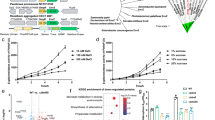Abstract
Zinc concentrations ranging between 0.1 and 1 mm only slightly reduced maximal growth of wild-type Pseudomonas aeruginosa 7NSK2 in iron-limiting casamino acid medium, but had a clear negative effect on the growth of mutant MPFM1 (pyoverdin negative) and especially mutant KMPCH (pyoverdin and pyochelin negative). Production of pyoverdin by wild-type strain 7NSK2 was significantly increased in the presence of 0.5 mm zinc and could not be repressed by iron even at a concentration of 100 μm. Siderophore detection via isoelectrofocusing revealed that mutant KMPCH did not produce any siderophores, while mutant MPFM1 overproduced a siderophore with an acidic isoelectric point, most likely pyochelin. Pyochelin production by MPFM1 was stimulated by the presence of zinc in a similar way as pyoverdin for the wild-type. Analysis of outer membrane proteins revealed that three iron regulated outer membrane proteins (IROMPs) (90, 85 and 75 kDa) were induced by iron deficiency in the wild-type, while mutants were found to have altered IROMP profiles. Zinc specifically enhanced the production of a 85 kDa IROMP in 7NSK2, a 75 kDa IROMP in MPFM1 and a 90 kDa IROMP in KMPCH.
Similar content being viewed by others
References
Ankenbauer RG. 1992 Cloning of the outer membrane high-affinity Fe(III)-pyochelin receptor of Pseudomonas aeruginosa. J Bacteriol 174, 4401–4409.
Baghdiantz A. 1952 Rôle du Zinc sur l'apparition de la composante II du ‘pigment’ de Pseudomonas fluorescens (Flügge-Migula). Arch Sci 5, 47–48.
Bagg A, Neilands JB. 1987 Ferric uptake regulation protein acts as a repressor, employing iron(II) as a cofactor to bind the operator of an iron transport operon in Escherichia coli. Biochemistry 26, 5471–5477.
Beringer JE, Beynon JL, Buchanan-Wollaston AV, Johnston AWB. 1978 Transfer of the drug-resistance transposon Tn5 to Rhizobium. Nature 276, 633–634.
Chakrabarty AM, Roy SC. 1964 Effect of trace elements on the production of pigments by a pseudomonad. Biochem J 93, 228–231.
Cornelis P, Moguilevski N, Jacques JF, Masson PL. 1987 Study of the siderophores and receptors in different clinical isolates of Pseudomonas aeruginosa. In: Döring G, Holder IA, Botzenhart K, eds. Basic Research and clinical aspects of Pseudomonas aeruginosa. Basel: Karger; 290–306.
Cornelis P, Hohnadel D, Meyer JM. 1989 Evidence for different pyoverdine-mediated iron uptake systems among Pseudomonas aeruginosa strains. Infect Immun 57, 3491–3497.
Cox CD, Graham R. 1979 Isolation of an iron-binding compound from Pseudomonas aeruginosa. J Bacteriol 137, 357–364.
Cox CD, Rinehart KL, Moore, ML, Cook, JC. 1981 Pyochelin: novel structure of an iron-chelating growth promoter for Pseudomonas aeruginosa. Proc Natl Acad Sci USA 78, 4256–4260.
Filip C, Fletcher G, Wulff JL, Earhart CF. 1973 Solubilisation of the cytoplasmic membrane of Escherichia coli by the ionic detergent sodium-lauryl sarcosinate. J Bacteriol 115, 717–722.
Heinrichs DE, Young L, Poole K. 1991 Pyochelin-mediated iron transport in Pseudomonas aeruginosa; involvement of a high-molecular-mass outer membrane protein. Infect Immun 59, 3680–3684.
Höfte M, Seong KY, Jurkevitch E, Verstraete W. 1991 Pyoverdin production by the plant growth promoting Pseudomonas strain 7NSK2: ecological significance in soil. Plant Soil 130, 249–258.
Huyer M, Page WJ. 1988 Zn2+ increases siderophore production in Azotobacter vinelandii. Appl Environ Microbiol 54, 2625–2631.
Huyer M, Page WJ. 1989 Ferric reductase activity in Azotobacter vinelandii and its inhibition by Zn2+. J Bacteriol 171, 4031–4037.
Iswandi A, Bossier J, Vandenabeele J, Verstraete W. 1987 Relation between soil microbial activity and the effect of seed inoculation with the rhizopseudomonad strain 7NSK2 on plant growth. Biol Fert Soils 3, 147–151.
Labeyrie S, Neuzil E. 1977 Influence des ions zinc et cobalt sur la chromogenèse de Pseudomonas aeruginosa en présence d'acide méthylphosphonique. Compt Rend Soc Biol 171, 755–759.
Laemmli UK. 1970 Cleavage of structural proteins during the assembly of the head of bacteriophage T4. Nature 227, 680–685.
Leong J, Bitter W, Koster M, Venturi V, Weisbeek PJ. 1991 Molecular analysis of iron transport in plant growth-promoting Pseudomonas putida WCS358. Biol Metals 4, 36–40.
Maniatis, T, Fritsch, EF, Sambrook, J. 1982 Molecular Cloning: A Laboratory Manual. Cold Spring Harbor, NY: Cold Spring Harbor Laboratory Press.
Meyer JM, Abdallah MA. 1978 The fluorescent pigment of Pseudomonas fluorescents: biosynthesis, purification and physicochemical properies. J Gen Microbiol 107, 319–328.
Meyer JM, Hohnadel D, Khan A, Cornelis P, 1990 Pyoverdin-facilitated iron uptake in Pseudomonas aeruGinosa: immunological characterization of the ferripyoverdin receptor. Mol Microbiol 4, 1401–1405.
Neilands JB. 1981 Microbial iron compounds. Annu Rev Biochem 50, 715–731.
O'Sullivan DJ, O'Gara F. 1990 Iron regulation of ferric iron uptake in a fluorescent Pseudomonas: cloning of a regulatory gene. Mol Plant-Microbe Interact 3, 86–93.
Poole K, Young L, Neshat S. 1990 Enterobactin-mediated iron transport in Pseudomonas aeruginosa. J Bacteriol 172, 6991–6996.
Poole K, Neshat S, Heinrichs D. 1991 Pyoverdin-mediated iron transport in Pseudomonas aeruginosa. FEMS Microbiol Lett 78, 1–6.
Seong KY. 1991 Plant growth promoting effect and ecophysiology of siderophore producing rhizopseudomonads. PhD Thesis, University of Gent, Belgium.
Schwyn B, Neilands JB. 1987 Universal chemical assay for the detection and determination of siderophores. Anal Biochem 160, 47–56.
Smith AW, Hist PH, Hughes K, Gensberg K, Govan RW. 1992 The pyocin Sa receptor of Pseudomonas aeruginosa is associated with ferripyoverdin uptake. J Bacteriol 174, 4847–4849.
Visca P, Colotti G, Serino L, Verzili D, Orsi N, Chiancone E, 1992 Metal regulation of siderophore synthesis in Pseudomonas aeruginosa and functional effects of siderophore-metal complexes. Appl Environ Microbiol 58, 2886–2893.
Wendenbaum S, Demange P, Dell A, Meyer JM, Abdallah MA. 1983 The structure of pyoverdine Pa, the siderophore of Pseudomonas aeruginosa. Tetrahedron Lett 24, 4887–4880.
Author information
Authors and Affiliations
Rights and permissions
About this article
Cite this article
Höfte, M., Buysens, S., Koedam, N. et al. Zinc affects siderophore-mediated high affinity iron uptake systems in the rhizosphere Pseudomonas aeruginosa 7NSK2. Biometals 6, 85–91 (1993). https://doi.org/10.1007/BF00140108
Received:
Accepted:
Issue Date:
DOI: https://doi.org/10.1007/BF00140108




